engine Citroen C5 RHD 2012 (RD/TD) / 2.G User Guide
[x] Cancel search | Manufacturer: CITROEN, Model Year: 2012, Model line: C5 RHD, Model: Citroen C5 RHD 2012 (RD/TD) / 2.GPages: 340, PDF Size: 39.41 MB
Page 27 of 340
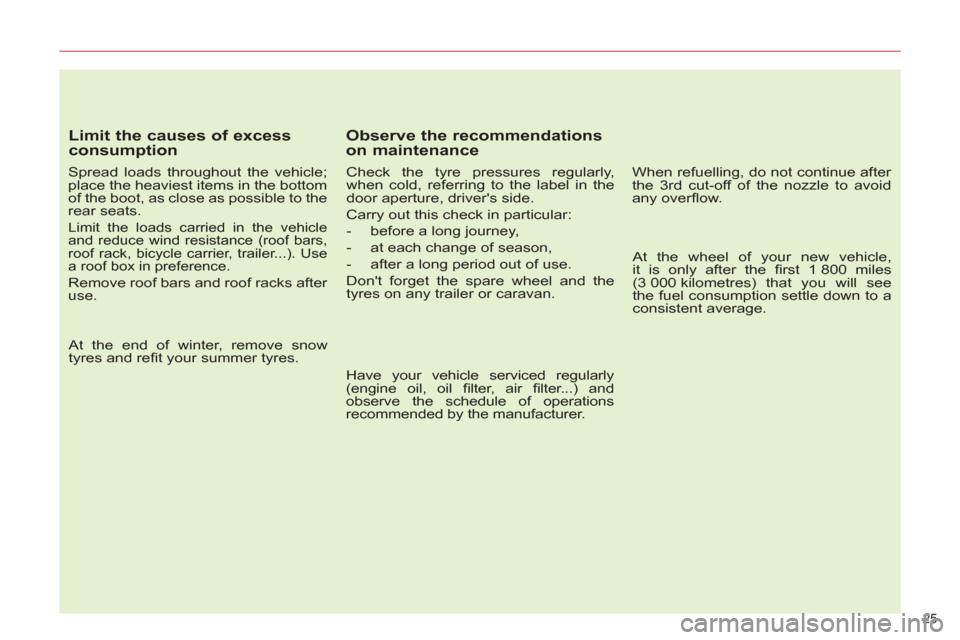
25
Limit the causes of excess
consumption
Spread loads throughout the vehicle;
place the heaviest items in the bottom
of the boot, as close as possible to the
rear seats.
Limit the loads carried in the vehicle
and reduce wind resistance (roof bars,
roof rack, bicycle carrier, trailer...). Use
a roof box in preference.
Remove roof bars and roof racks after
use.
At the end of winter, remove snow
tyres and refi t your summer tyres.
Observe the recommendations
on maintenance
Check the tyre pressures regularly,
when cold, referring to the label in the
door aperture, driver's side.
Carry out this check in particular:
- before a long journey,
- at each change of season,
- after a long period out of use.
Don't forget the spare wheel and the
tyres on any trailer or caravan.
Have your vehicle serviced regularly
(engine oil, oil fi lter, air fi lter...) and
observe the schedule of operations
recommended by the manufacturer.
When refuelling, do not continue after
the 3 rd cut-off of the nozzle to avoid
any overfl ow.
At the wheel of your new vehicle,
it is only after the fi rst 1 800 miles
(3 000 kilometres) that you will see
the fuel consumption settle down to a
consistent average.
Page 28 of 340
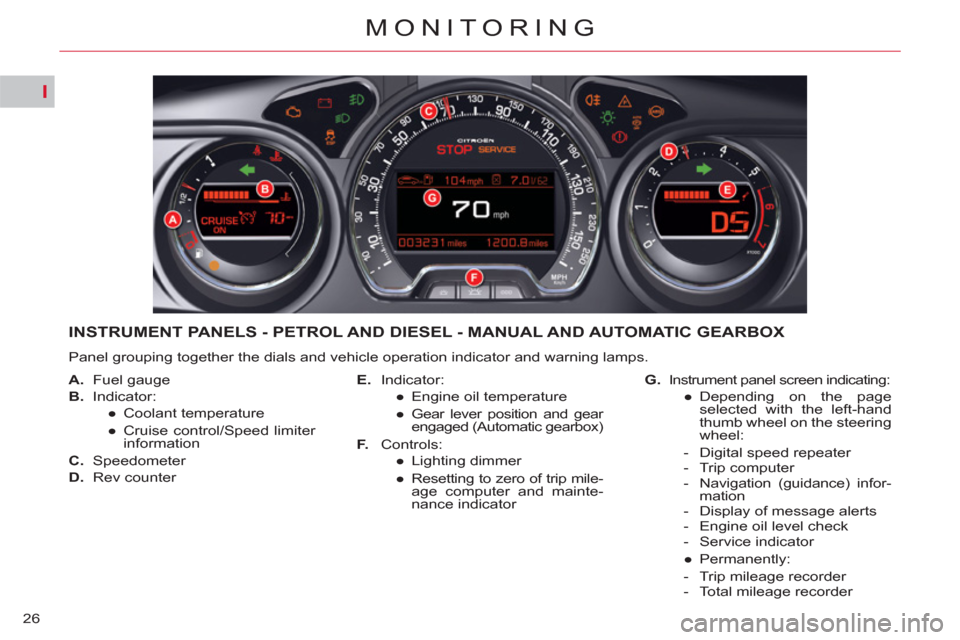
I
26
MONITORING
INSTRUMENT PANELS - PETROL AND DIESEL - MANUAL AND AUTOMATIC GEARBOX
Panel grouping together the dials and vehicle operation indicator and warning lamps.
A.
Fuel gauge
B.
Indicator:
●
Coolant temperature
●
Cruise control/Speed limiter
information
C.
Speedometer
D.
Rev counter
E.
Indicator:
●
Engine oil temperature
●
Gear lever position and gear
engaged (Automatic gearbox)
F.
Controls:
●
Lighting dimmer
●
Resetting to zero of trip mile-
age computer and mainte-
nance indicator
G.
Instrument panel screen indicating:
●
Depending on the page
selected with the left-hand
thumb wheel on the steering
wheel:
- Digital speed repeater
- Trip computer
- Navigation (guidance) infor-
mation
- Display of message alerts
- Engine oil level check
- Service indicator
●
Permanently:
- Trip mileage recorder
- Total mileage recorder
Page 34 of 340

I
32
MONITORING
Warning and indicator lamps
Visual indicators which inform the driver of the occurrence of a malfunction or
fault (warning lamp) or of the operation of a system (operation or deactivation
indicator lamp).
Warning lamp
is on
Cause
Action/Observations
STOP
fi xed, associated
with another
warning lamp. It is associated with a
punctured tyre or the engine
coolant temperature. Stop as soon as it is safe to do so.
Park, switch off the ignition and call a
CITROËN dealer or a qualifi ed workshop.
Service
temporarily. A minor fault has occurred
for which there is no specifi c
warning lamp. Identify the fault by reading the message
shown in the screen, such as, for example:
- the closing of the doors, boot, rear
screen or bonnet,
- the remote control battery,
- the tyre pressures,
- saturation of the particle emission fi lter
(Diesel).
For any other faults, contact a CITROËN
dealer or a qualifi ed workshop.
fi xed. A major fault has occurred
for which there is no specifi c
warning lamp. Identify the fault by reading the message
shown in the screen and contact a
CITROËN dealer or a qualifi ed workshop.
When the ignition is switched on
Certain warning lamps come on for a few seconds when the ignition is switched on.
When the engine is started, these warning lamps should go off.
If they remain on, before moving off, refer to the information for the warning
lamp concerned.
Associated warnings
The illumination, fi xed or fl
ashing, of certain warning lamps may be accompa-
nied by an audible signal and a message in the screen.
Warning lamps
When the engine is running or the
vehicle is being driven, the illumina-
tion of one of the following warning
lamps indicates a malfunction or
fault which requires action on the
part of the driver.
The illumination of a warning lamp is
always accompanied by the display
of an additional message, to assist
you in identifying the fault.
If you encounter any problems, con-
tact a CITROËN dealer or a qualifi ed
workshop.
Page 36 of 340

I
34
MONITORING
Dynamic
stability
control
(ESP/ASR)
fl ashing. The ESP/ASR regulation is
active. The system optimises traction and
improves the directional stability of
the vehicle.
fi xed, accompanied
by an audible signal
and a message in
the instrument panel
screen.
Unless it has been deactivated
with the indicator lamp in
the button on, the ESP/ASR
system has a fault. Have it checked by a CITROËN dealer or a
qualifi ed workshop.
Engine
autodiagnosis
system
fi xed. The emission control system
has a fault. The warning lamp should go off when
the engine is started.
If it does not go off, contact a CITROËN
dealer or qualifi ed workshop without delay.
fl ashing. The engine management
system has a fault. Risk of destruction of the catalytic converter.
Have it checked by a CITROËN dealer or
a qualifi ed workshop.
Warning lamp
is on
Cause
Action/Observations
Brake pad
wear
fi xed, accompanied
by an audible signal
and a message in
the multifunction
screen.
The brake pads are at an
advanced state of wear. Have the brake pads replaced by a
CITROËN dealer or a qualifi ed workshop.
Deactivation of
the automatic
functions of
the electric
parking brake
fi xed. The "automatic application"
(on switching off the engine)
and "automatic release"
functions are deactivated or
faulty. Activate the function (according to country)
via the vehicle confi guration menu or
contact a CITROËN dealer or a qualifi ed
workshop if automatic application/release is
not possible.
The parking brake can be released
manually using the emergency release
procedure.
For more information on the electric parking
brake, refer to the "Driving" section.
Page 37 of 340

I
35
MONITORING
Warning lamp
is on
Cause
Action/Observations
Low fuel
level
fi xed. When it fi rst comes on there
remains approximately
5 litres of
fuel
in the tank. You must refuel as soon as possible to
avoid running out of fuel.
This warning lamp wil come on every time
the ignition is switched on, until a suffi cient
addition of fuel is made.
Fuel tank capacity: 71 litres.
Never continue to drive until you run out
of fuel, this could damage the emission
control and injection systems.
Maximum
coolant
temperature
fi xed red. The temperature of the
cooling system is too high. Stop as soon as it is safe to do so.
Wait until the engine has cooled down
before topping up the level, if necessary.
If the problem persists, contact a
CITROËN dealer or qualifi ed workshop.
Battery
charge
fi xed. The battery charging circuit
has a fault (dirty or loose
terminals, slack or cut
alternator belt, ...). The warning lamp should go off when the
engine is started.
If it does not go off, contact a CITROËN
dealer or a qualifi ed workshop.
+
Seat belt not
fastened/
unfastened
fi xed.
The driver and/or the front/
rear passenger has not
fastened or has unfastened
their seat belt. Pull the strap then insert the tongue in
the buckle.
Seat belts
not fastened/
unfastened
fi xed, associated
with the seat belt
not fastened/
unfastened
warning lampl. The illuminated dots represent the not
fastened/unfastened passengers. They come on:
- fi xed for 30 about seconds on starting the
vehicle,
- fi xed from 0 to 12 mph (0 to 20 km/h) when
driving,
-
fl ashing above 12 mph (20 km/h), accompanied
by an audible signal for about 120 seconds.
Page 39 of 340
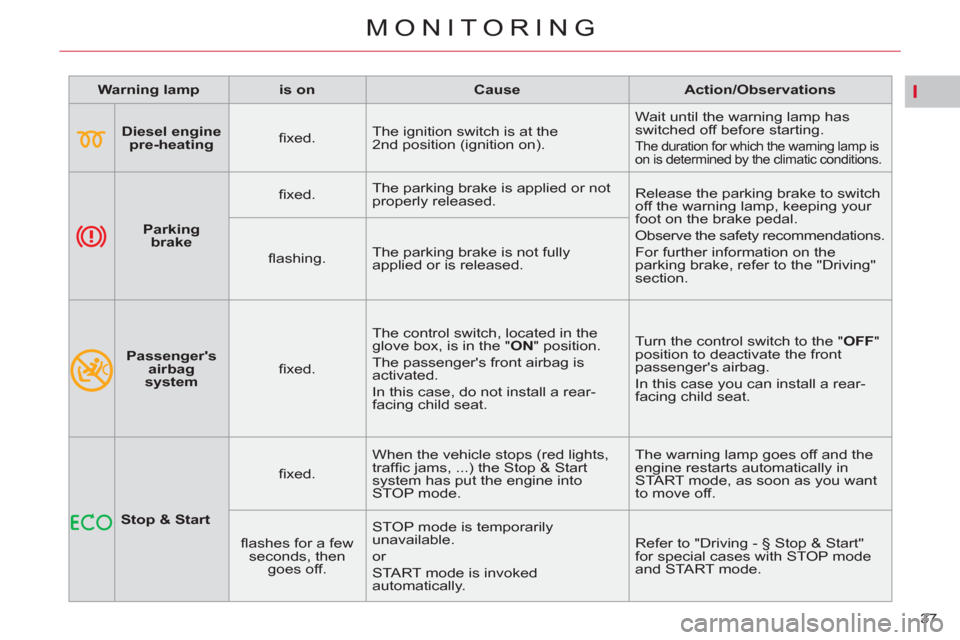
I
37
MONITORING
Warning lamp
is on
Cause
Action/Observations
Diesel engine
pre-heating
fi xed. The ignition switch is at the
2nd position (ignition on). Wait until the warning lamp has
switched off before starting.
The duration for which the warning lamp is
on is determined by the climatic conditions.
Parking
brake
fi xed. The parking brake is applied or not
properly released. Release the parking brake to switch
off the warning lamp, keeping your
foot on the brake pedal.
Observe the safety recommendations.
For further information on the
parking brake, refer to the "Driving"
section.
fl ashing. The parking brake is not fully
applied or is released.
Passenger's
airbag
system
fi xed. The control switch, located in the
glove box, is in the " ON
" position.
The passenger's front airbag is
activated.
In this case, do not install a rear-
facing child seat. Turn the control switch to the " OFF
"
position to deactivate the front
passenger's airbag.
In this case you can install a rear-
facing child seat.
Stop & Start
fi xed. When the vehicle stops (red lights,
traffi c jams, ...) the Stop & Start
system has put the engine into
STOP mode. The warning lamp goes off and the
engine restarts automatically in
START mode, as soon as you want
to move off.
fl ashes for a few
seconds, then
goes off. STOP mode is temporarily
unavailable.
or
START mode is invoked
automatically. Refer to "Driving - § Stop & Start"
for special cases with STOP mode
and START mode.
Page 42 of 340

I
40
MONITORING
Service indicator zero reset
After each service, the service indi-
cator must be reset to zero.
The procedure for resetting to zero
is as follows:
�)
switch off the ignition,
�)
press and hold the trip distance
recorder zero reset button,
�)
switch on the ignition; the dis-
tance recorder display begins a
countdown,
�)
when the display indicates "=0"
,
release the button; the spanner
disappears.
Following this operation, if you wish
to disconnect the battery, lock the
vehicle and wait at least fi ve minutes
for the zero reset to be taken into
account.
Engine oil level indicator
System which informs the driver
whether the engine oil level is correct
or not.
This information is indicated for a
few seconds when the ignition is
switched on, after the service infor-
mation.
The level read will only be correct if
the vehicle is on level ground and
the engine has been off for more
than 15 minutes.
Oil level correct
Oil level incorrect
This is indicated by displaying of the
message "Oil level incorrect".
If the low oil level is confi rmed by a
check using the dipstick, it is essen-
tial that the level is topped up to pre-
vent damage to the engine.
Oil level gauge fault
This is indicated by displaying of the
message "Oil level measurement in-
valid". Contact a CITROËN dealer
or a qualifi ed workshop.
Page 43 of 340
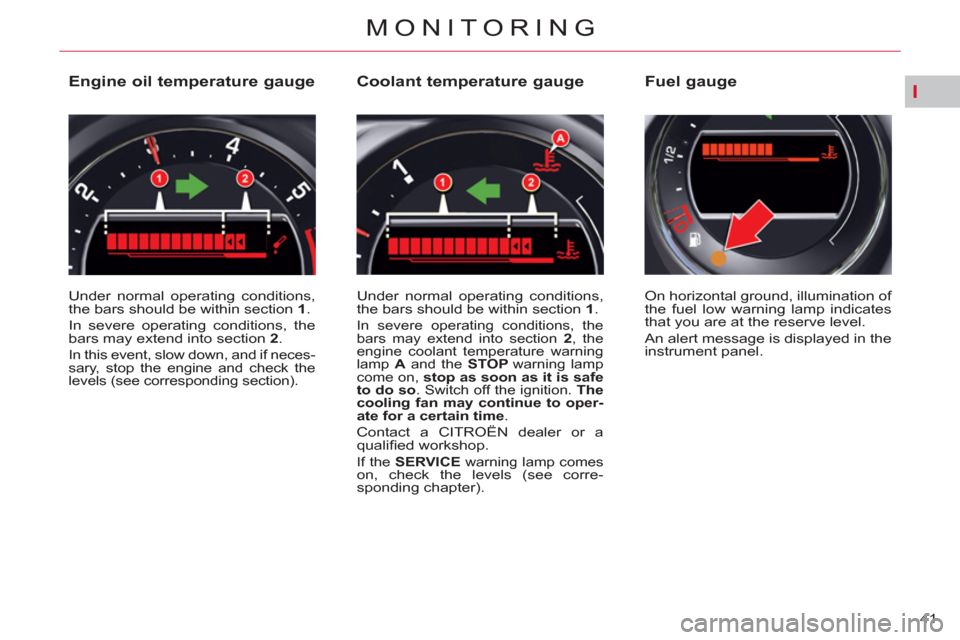
I
41
MONITORING
Engine oil temperature gauge
Under normal operating conditions,
the bars should be within section 1
.
In severe operating conditions, the
bars may extend into section 2
.
In this event, slow down, and if neces-
sary, stop the engine and check the
levels (see corresponding section).
Coolant temperature gauge
Under normal operating conditions,
the bars should be within section 1
.
In severe operating conditions, the
bars may extend into section 2
, the
engine coolant temperature warning
lamp A
and the STOP
warning lamp
come on, stop as soon as it is safe
to do so
. Switch off the ignition. The
cooling fan may continue to oper-
ate for a certain time
.
Contact a CITROËN dealer or a
qualifi ed workshop.
If the SERVICE
warning lamp comes on, check the levels (see corre-
sponding chapter). On horizontal ground, illumination of
the fuel low warning lamp indicates
that you are at the reserve level.
An alert message is displayed in the
instrument panel.
Fuel gauge
Page 52 of 340
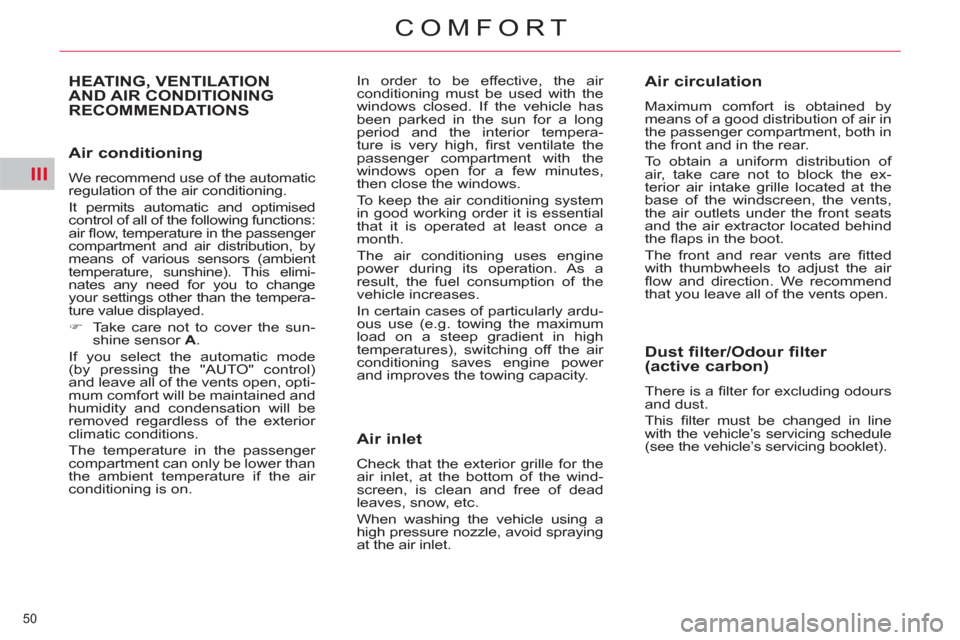
III
50
COMFORT
Air conditioning
We recommend use of the automatic
regulation of the air conditioning.
It permits automatic and optimised
control of all of the following functions:
air fl ow, temperature in the passenger
compartment and air distribution, by
means of various sensors (ambient
temperature, sunshine). This elimi-
nates any need for you to change
your settings other than the tempera-
ture value displayed.
�)
Take care not to cover the sun-
shine sensor A
.
If you select the automatic mode
(by pressing the "AUTO" control)
and leave all of the vents open, opti-
mum comfort will be maintained and
humidity and condensation will be
removed regardless of the exterior
climatic conditions.
The temperature in the passenger
compartment can only be lower than
the ambient temperature if the air
conditioning is on.
HEATING, VENTILATION
AND AIR CONDITIONING
RECOMMENDATIONS In order to be effective, the air
conditioning must be used with the
windows closed. If the vehicle has
been parked in the sun for a long
period and the interior tempera-
ture is very high, fi rst ventilate the
passenger compartment with the
windows open for a few minutes,
then close the windows.
To keep the air conditioning system
in good working order it is essential
that it is operated at least once a
month.
The air conditioning uses engine
power during its operation. As a
result, the fuel consumption of the
vehicle increases.
In certain cases of particularly ardu-
ous use (e.g. towing the maximum
load on a steep gradient in high
temperatures), switching off the air
conditioning saves engine power
and improves the towing capacity.
Air inlet
Check that the exterior grille for the
air inlet, at the bottom of the wind-
screen, is clean and free of dead
leaves, snow, etc.
When washing the vehicle using a
high pressure nozzle, avoid spraying
at the air inlet.
Air circulation
Maximum comfort is obtained by
means of a good distribution of air in
the passenger compartment, both in
the front and in the rear.
To obtain a uniform distribution of
air, take care not to block the ex-
terior air intake grille located at the
base of the windscreen, the vents,
the air outlets under the front seats
and the air extractor located behind
the fl aps in the boot.
The front and rear vents are fi tted
with thumbwheels to adjust the air
fl ow and direction. We recommend
that you leave all of the vents open.
Dust filter/Odour filter
(active carbon)
There is a fi lter for excluding odours
and dust.
This fi lter must be changed in line
with the vehicle’s servicing schedule
(see the vehicle’s servicing booklet).
Page 53 of 340

III
51
COMFORT
DIGITAL AIR CONDITIONING (MONO-ZONE)
This is the normal sys-
tem operating mode.
In accordance with the
level of comfort chosen,
pressing this control,
confi rmed illumination
of indicator lamp A
, permits automatic
and simultaneous control of all of the
following functions:
- Air fl ow.
- Temperature in the passenger
compartment.
- Air distribution.
- Air intake.
- Air conditioning.
1. Automatic operation
It is advisable to leave all of the
vents open.
Simply pressing one of the controls,
with the exception of control 2
, switches
the system to manual mode.
Indicator lamp A
goes off.
2. Temperature adjustment
Turn control 2
to change
the temperature:
-
Clockwise to increase
the temperature.
- Anticlockwise to re-
duce the temperature.
The setting required is displayed.
The value indicated in the screen
corresponds to a level of comfort
and not to a temperature in degrees
Celsius or Fahrenheit, depending on
the screen confi guration.
A setting around the value 21
usu-
ally provides optimum comfort.
However, depending on your re-
quirements, a setting between 18
and 24 is normal.
On entering the vehicle, the interior
temperature may be much colder (or
warmer) than is comfortable. There
is no need to change the tempera-
ture displayed to obtain rapidly the
level of comfort required.
The automatic regulation of the air
conditioning will use its maximum
performance settings to correct the
temperature difference as quickly as
possible. The air conditioning system operates
with the engine running.
Mono-zone:
this is the overall
regulation of the temperature, distri-
bution and fl ow of air in the passenger
compartment.
The symbols and messages associ-
ated with the digital air conditioning
controls appear in the multifunction
screen.
1.
Automatic operation
2.
Temperature adjustment
3.
Air distribution adjustment
4.
Activation/deactivation of the air
conditioning
5.
Air fl ow adjustment
6.
Front demisting - defrosting
7.
Rear demisting - defrosting
8.
Air recirculation - intake of exterior
air
9.
Screen